
The Wakefield Trust Company is a historic commercial building at 371 Main Street in Wakefield, Massachusetts. Built in 1924, it is one of three buildings on the west side of Main Street that give the town center a strong Classical Revival flavor. The building was listed on the National Register of Historic Places in 1989.

The New Hampshire Bank Building is a historic commercial building at 22-26 Market Square, Portsmouth, New Hampshire. Built in 1803 and much altered since, it is one of the nation's oldest purpose-built bank buildings, and was until 1977 the oldest building used continuously to house banking operations. It was added to the National Register of Historic Places in 1979.

Davenport Bank and Trust Company was for much of the 20th century the leading bank of the Quad Cities metropolitan area and the surrounding region of eastern Iowa and western Illinois. It was at one time Iowa's largest commercial bank, and the headquarters building has dominated the city's skyline since it was constructed in 1927 at the corner of Third and Main Streets in downtown Davenport, Iowa. It was acquired by Norwest Bank of Minneapolis in 1993 and now operates as part of Wells Fargo following a 1998 merger of the two financial institutions. The historic building was listed on the National Register of Historic Places in 1983 under the name of its predecessor financial institution American Commercial and Savings Bank. In 2016 the National Register approved a boundary increase with the Davenport Bank and Trust name. It was included as a contributing property in the Davenport Downtown Commercial Historic District in 2020. It remains the tallest building in the Quad Cities, and is today known as Davenport Bank Apartments as it has been redeveloped into a mixed-use facility housing commercial, office, and residential space.

The Roslyn Savings Bank Building is a landmarked, historic commercial building located on Old Northern Boulevard in the Incorporated Village of Roslyn, in the Town of North Hempstead, Nassau County, Long Island, New York, United States.
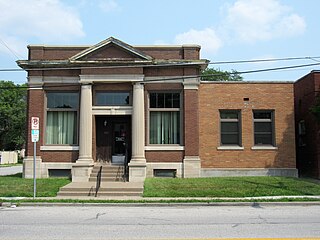
Northwest Davenport Savings Bank is a historic building located in a commercial district in the old northwest section of Davenport, Iowa, United States. It has been listed on the National Register of Historic Places since 1984.
Mowbray & Uffinger comprised an architectural partnership in New York City formed in 1895. Known for bank buildings and as vault engineers they designed over 400 banks in the pre-World War II era throughout the country. The principals were Louis Montayne Mowbray (1867-1921) and Justin Maximo Uffinger Sr. (1871-1948).

The White Horse Tavern is an historic, American inn and tavern that is located in Douglassville, Amity Township, Berks County, Pennsylvania.

Dime Bank Building, also known as the Dime Bank & Trust Company Building, is a historic commercial building located at Scranton, Lackawanna County, Pennsylvania. It is a five-story brick building in the Richardsonian Romanesque style. The original three-story building was built in 1890-1891, and measured 70 by 70 feet. Soon after, an additional two-stories were added, as well as a wing measuring 30 by 175 feet. In 1908, the building was again expanded with a concrete and slab fireproof wing. The facade features a delicately ornamented bay window, five-story turret, and three-story rectangular projection terminated at the third floor by a large arched masonry opening.

The Lancaster Trust Company is an historic, American bank building that is located in Lancaster, Lancaster County, Pennsylvania.

The Dime Savings and Trust Company, also known as the First Valley Bank, is an historic bank building located in Allentown, Pennsylvania. It was built in 1925, and is a T-shaped, five-story red brick building.

Alexander K. McClure School is a historic elementary school located in the Hunting Park neighborhood of Philadelphia, Pennsylvania. It is part of the School District of Philadelphia. The building was designed by Henry deCourcy Richards and built in 1910–1911. It is a three-story, five-bay, brick building with a raised basement in the Colonial Revival-style. It features a three-story, rounded arched opening above the entrance, stone trim, and a rounded parapet. An addition was built in 1967. The school was named for journalist and politician Alexander Kelly McClure.

The John Marshall Elementary School is an historic elementary school that is located in the Frankford neighborhood of Philadelphia, Pennsylvania. It is part of the School District of Philadelphia.
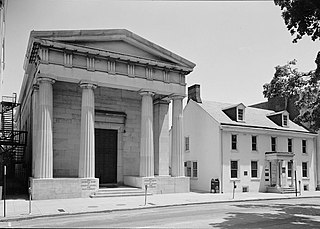
Bank of Chester County is a historic two-story bank building located in West Chester, Chester County, Pennsylvania, the first bank to be chartered in the county. Following the failure to renew the charter of the Bank of the United States in 1811, states received responsibility over the banking systems within their jurisdiction. Although an initial proposal was rejected by the state legislature in 1813, a 41-bank proposal was passed the following year. An early bank building was utilized in West Chester beginning in 1814 at the Record Office, though the bank was relocated in 1818 to a building across the street, present-day 13 High Street. Following a proposal for a new site in 1835, a bank, to be built at 17 High Street, designed by architect Thomas Ustick Walter (1804–1887). It was built in 1836 in the Greek Revival style at the cost of $33,000, and features a portico with four Doric order columns; the bank was subsequently altered in 1874, 1905, and 1928. The previous building has since been rented to numerous individuals, although it still houses outdated equipment no longer used by the bank. The current building is occupied by Wells Fargo.
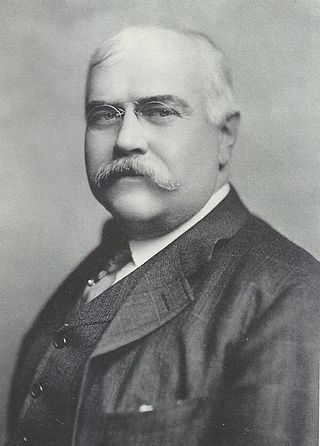
Alvan Markle was an American banker, businessman, engineer, and inventor based in Hazleton, Pennsylvania. He was the son of George Bushar Markle (1827–1888), a rural carpenter and ingenious inventor who became a successful banker and coal operator. Alvan was the brother of John Markle, who established the John and Mary Markle Foundation. Alvan, his father, and his brothers were instrumental in making Hazleton a financial and industrial hub through their inventions and their initiative in establishing regional transportation systems, electric power, extraction technologies, as well as social and educational institutions.

Raleigh Banking and Trust Company Building, also known as the Raleigh Building, is a historic bank office building located at Raleigh, North Carolina. It is an eleven-story, seven bays wide and three bays deep, Classical Revival style skyscraper. It is a steel frame and brick veneer building with white terra cotta ornamental elements. The first three stories were built in 1913, with the upper eight stories added in 1928–1929. The first three floors were radically renovated in 1935–1936, with the addition of Art Moderne design elements.

Farmers and Merchants Savings Bank, also known as Union Savings Bank and First Trust and Savings Bank, is an historic building located in Grand Mound, Iowa, United States. It was listed on the National Register of Historic Places in 2001.

The Branch Banking Company Building is a historic bank building located in Wilson, North Carolina. It was built by the Branch Banking and Trust Company in 1903, and is a two-story, rectangular, blond brick building in the Classical Revival / Renaissance Revival style. A three bay extension was built in 1934. It features reddish sandstone detailing such as the window surrounds, pediment, columns and capitals; and an overhanging pressed metal cornice. It was listed on the National Register of Historic Places in 1978. It is located in the Wilson Central Business-Tobacco Warehouse Historic District.

The Union Banking Company Building is a historic three-story brick building in Douglas, Georgia. The building was built in 1910-11 and has two facades facing streets, which include ten distinctive terracotta gargoyles. It is located at the intersection of Peterson Avenue and Ward Street.
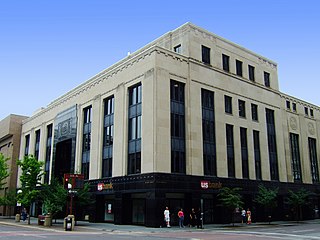
The Iowa-Des Moines National Bank Building, also known as the Valley National Bank Building and U.S. Bank, is a historic building located in downtown Des Moines, Iowa, United States. Designed by the prominent Des Moines architectural firm of Proudfoot, Rawson, Souers & Thomas, it was designed to be a 21- or 22-story building. It is one of the few downtown commercial buildings built in the Art Deco style. It is also thought to be one of the first bank buildings to put the banking room on the second floor while placing retail space on the first floor. Given its location in an area dominated by retail this made sense. This location had a bank on it since 1882 when the Des Moines National Bank built here. The present building was the result when Des Moines National Bank merged with Iowa National Bank and Des Moines Savings Bank and Trust Company in 1929. The original design for the building was a five-story base and a set-back rental office tower on top of it. The base was begun in 1931 and completed a year later. The building is composed of black polished granite on the first floor and the upper floors are Bedford stone. There is a recessed entrance in the center bay of the main facade. The fifth floor was meant to be the base of the office tower that was never built.
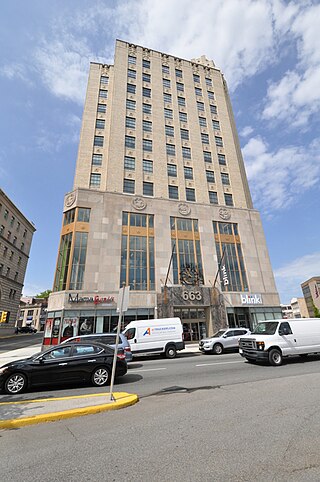
The People's Bank and Trust Company Building is an Art Deco skyscraper built in 1931 and located at 663 Main Avenue in the city of Passaic in Passaic County, New Jersey. The 154-foot (47 m) tall building is the highest in the city. It was added to the National Register of Historic Places on November 19, 2018, for its significance in architecture. Vacant since 1994, it is now owned by the Passaic Urban Enterprise Zone.
























